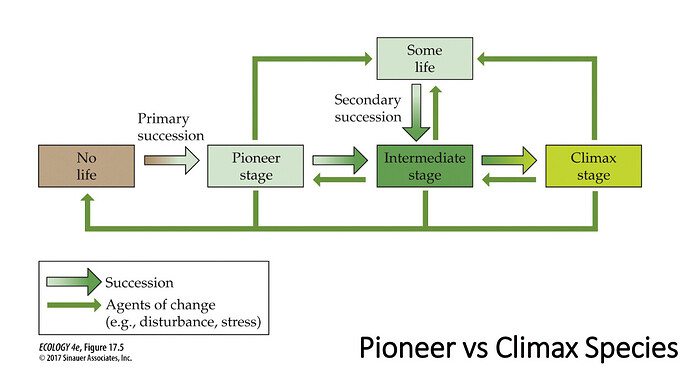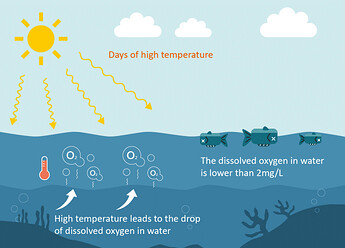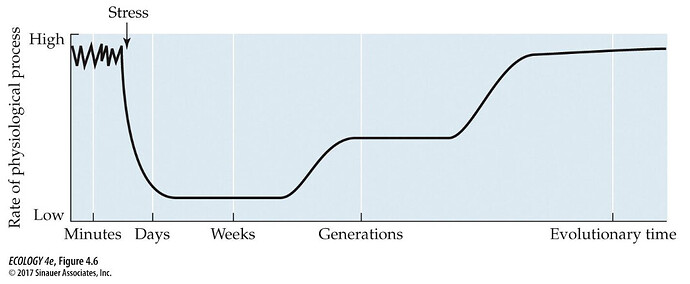First of all - some notes:
-
This thread won’t talk about whether or not there was extinction in the game. This has been agreed upon in the past numerous times. Welcome to see here: Some ideas on extinction events and tracking of species, The Philosophy of Thrive – How Evolutionary Progression Should Work
-
It will focus on one direction around this topic - if by chance it is decided to put it into the game in one way or another, how would it be? As an explanation, this comes from my opinion only and if my opinion disagrees with yours, I would love to know why.
-
Of course, like all my previous opinions, I think it would be appropriate to admit that my writing in English is not the best, and I would be happy if you would at least ignore it, and if a certain part is not understood, I would love to know. using google translate has its flaws.
Shall we begin?
Introduction - “What is extinction?”
Extinction is a biological process in which the last individual of a particular species dies and cannot reproduce naturally or has no living descendants. When this happens, this species is defined as extinct.
This is the dictionary term.
But the question is why do species become extinct?
There are several ways that species can become extinct:
- Environmental disaster - a volcano erupted and everyone around him died.
- Environmental processes - climate change causes a change in the composition of food in an ecological area of a certain species, it is unable to cope and becomes extinct as a result.
- Biological - competition between a new species that entered the ecosystem and the species that were present. Ultimately, there cannot be the same species eating the same food, causing competition where one species succeeds and the other becomes extinct from the area. In the worst case, even extinct altogether.
- Evolution - a species that develops into another species by biological definition, will also be considered extinct.
( Extinction | Definition & Examples | Britannica)
What is species?
Individuals capable of breeding with each other and giving birth to fertile offspring, are called species. A horse and a donkey can breed one other, but not give birth to fertile offspring (a mule). because of that, they are considered separate species. This is due to a large number of reasons, most of which are not relevant (change in the shape of chromosomes and genes, silencing or switching on of genes, etc.), but this concept is relevant to what will be discussed later.
What is mass extinction?
When an extinction event happens to a large variety of species in a short geological time (between a few decades and a few million years), it is defined as a mass extinction.
The same concept is a bit vague when we consider the number of fossils or the statistical data we have at the time of writing these lines.
Example: It was thought that there was a mass extinction that happened right after the Cambrian explosion but after the discovery of fossils in later periods of species similar to those that existed and not between these 2 periods. Is this considered a mass extinction? It turns out that we simply lack fossils or knowledge between these 2 periods. Cambrian–Ordovician extinction event - Wikipedia, End-Ediacaran extinction - Wikipedia (a subject that is still under research, so things can change, Since these ancient times it is difficult to preserve things)
So how do you know if it is a mass extinction or not? Hard to say, but not necessarily impossible. Other signs can indicate a mass extinction - a big drastic change between the 2 periods sometimes accompanied by a change in the color of the earth - as in the case of the KT extinction (also known as the extinction of the dinosaurs):
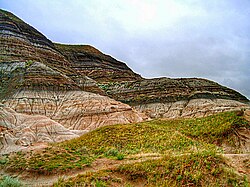
As of now, we know of 5 major mass extinctions (even 6, if you count today). Each of them is caused by different factors. Most of them are environmental changes or natural disasters.
Thus it can be seen that extinction is a natural process, and it is also a cornerstone for changes and evolutionary development of many species. When one species becomes extinct, a new niche opens up for other species to fill, causing a behavioral and physical change to adapt to its role.
Pioneers and establishment
The image above simply explains how species spread to a new environment, such as a newly formed island.
But let’s scale it up to a post-extinction event:
In the process of settling a new ecological niche, there was usually such a specific order:
General species - those that usually do not need many resources to exist or do not choose what they eat, will soon populate the area.
After that, species specializing in a certain area of a niche (carnivores or omnivores) will fill the gap and so on until each niche is filled (niche - a living area suitable for the needs of a certain species - Ecological niche - Wikipedia)
This is possible only under one condition - if the external environment is stable enough.
If there is an environment where there is too much of it missing or the creatures living in it are not able to develop fast enough to the environmental conditions, the ecosystem collapses and then enters a state known as “Collapse”, and when this happens, such a system takes hundreds of thousands of years to recover. An excellent analogy is the Permian-Triassic extinction. Extinction was caused by the ongoing eruption of a supervolcano that filled the atmosphere with ash and chemicals that caused enormous damage to the entire biosphere during this period. 70% of the terrestrial creatures and 95% - 98% of the marine species became extinct. Such an ecosystem took an estimated 9 million years until it became stable again and could sustain itself if in a state of stress (an event of stress) it returned. ( Permian extinction, facts and information , Permian extinction | Overview & Facts | Britannica)
We can summarize when we talk about extinction, it can spread between a point event, or a global event and can change the direction of the biosphere, or even end it.
What is the extinction in the current situation of the game?
(Correct at the time of writing these lines)

Who remembers that message when your last species went extinct?
As we play the game, we know a few things for all evolution enthusiasts-
survive or die
In the past (I think before version 0.53), there is a little meter on the side that says how many of your species’ population is alive, and if you get to 0, your species is extinct and you lose (and get that message above). That’s all there was to cause extinction.
Now (as of this writing), the hunt is better - the little gauge on the side tells you how much population there is in that particular patch, and once it drops to zero, your species is gone from that patch and you’re forced to play one of the patches you were in before.
Why is it good? Because this is a more realistic measure of what happens in reality - species exist in other areas besides the patches where it was, and it also opens up a challenge of trying to stay where you want to be and if you don’t succeed, you can try again in the next evolutionary incarnation.
the problem? I will list it in this way:
You are a plant that lives in patches where there is continuous sunlight, but then there is a bacterium that drastically harms that (like perhaps toxins) and causes you to become extinct. Here comes a small problem - if the game records all the places where your species has been during the game, but you have developed something that does not exist in the other places, then what happens in this situation? If you passed through the place where it is, you are saved. But if not, you are doomed to die - you are too slow to hunt and there is not enough energy source available to fuel your body adapted to a different environment. It doesn’t sound fun nor does it sound that realistic - as we know that species migrate all the time.
With the advent of climate resistance (you can find the discussion here: Environmental Tolerance Adaptations - #34 by Deus - Gameplay - Thrive Development Forum), I think this is also an excellent point to touch on here - species that are not adapted to a certain environment, should not be there. Alternatively - a similar environment leads to species that are adapted to a similar environment and are close to it, to spread to it - either by your decision or not. In this way, it is also an excellent tool for the player in the case and such a situation reflects the realism of the movement of species.
Admittedly, it wouldn’t solve everything - cave-dwelling species were in even more difficult conditions than I mentioned, and if it worked that way, wouldn’t that mean they would go extinct more easily? Not necessarily, but that’s how it is in reality.
This solution is simple and we have already changed the tools in my opinion to work on it and I think the developers also know about this problem, but it was appropriate to write it in case I am wrong.
There is also planning regarding taking control of related species:
“Feature to allow swapping to a related species on extinction (selectable only in easy mode)”
( Release Roadmap - Thrive Developer Wiki)
Just for the reminder
And what about other species besides the actor?
The extinction of other species has been understood in the game for a long time - a change in the population due to various and varied factors - they are due to lack of success or the player’s influence on these species. is based and feels, in my opinion, in good condition. Especially as they presented the evolutionary family tree (the phylogenetics tree model), we see in history that species become extinct. But they are the next of environmental changes, I guess we will see more of this there. More than that, I guess they should work similar to what I suggested above which was closer to reality. But big changes don’t happen slowly, therefore, I leave them as they are now and the decision to change is of course in the hands of those in charge.
How to represent “mass” extinctions?
This is something that comes up several times - with it will come, how will it be presented?
Already on their wiki site he wrote the following:
"Though some factors of a biome are relatively constant, some can be subject to change from natural phenomena. For example the ocean surface may start deoxygenated, but years of photosynthesis could lead to an oxygenation event ultimately leading to a buildup of oxygen in the ocean surface. "
( Microbe Biomes - Thrive Developer Wiki)
According to their words - they want in the beginning the world to be without oxygen until life begins to develop photosynthesis and then oxygen begins to appear and affect life.
Such an event happened in the past on Earth, known as the “Great Oxidation Event”, but many know it by another name - “Oxygen Catastrophe”.
Extinction by atmospheric change
I chose this example to get started on how to represent him. This is probably the easiest way out of the rest for the simple reason that it doesn’t take much work to represent it (putting it into action is something else) - the atmospheric change uniform already exists in the game and has not been touched.
But their plans for the future the game will completely change how it will be played and can also give additional alternative options (if they are open).
But here the question arises - how to represent such a thing?
I’m not an advanced game engineer, so the UI is not my thing, but I think it would be appropriate to represent it in some way and here I offer 2 different options:
Option 1: message
The fairest way is to display a message:
“For the first time in history - a living creature developed the way to use the source from the sun, air and water to create food for itself. Life was no longer the same”
This was a seemingly innocuous message, but some smart people (like us) know that this is a warning call to the future - oxygen is toxic. Our body is organized to counter its ability to oxidize things, something living creatures do not want to happen to their delicate system. From this point - if they have not succeeded in the task of confronting the advancing and coming event, they will begin to feel the consequences - they will feel more sluggish than usual and a decline in their life. It was more extreme as the oxygen levels increased and above a certain level, even fatal. This message was one way to present the disaster simply, but I have another idea:
Option 2: Color change
Gases even though they are invisible, scientists use one small fact about it - gases are able to absorb light at a certain level and are also able to change the color of other substances (What Is the Color of Oxygen: Properties and Exciting Facts).
As a matter of fact, there is a small story from that event of the great oxidation - iron before the presence of oxygen was gray and when oxygen first appeared, the oxygen was not released immediately, the iron absorbed them and became oxidized iron (or rust), which is characterized by its famous blood-red color (small fact - used in this for fake blood in the cinema) and the iron sinks. That’s why in geology, you can see signs of rusty iron in sediments over the millions of years:
Although photosynthesis existed before, until all the iron reserves around the planet were oxidized, there was no oxygen in the atmosphere and as soon as that happened, the oxygen disaster began.
Species that could not fight against the oxygen, became extinct or were forced to hide in oxygen-deprived places (under the ground or in caves). And those who did, continued with their lives as usual, and some even took advantage of the disadvantage, which led to the complex systems we know.
The color change could be when the water turned red for a few generations before oxygen appeared, could give a warning that something unusual is going on - a big warning.
Alternatively, you can combine the 2 options just to strengthen the change.
Alternatively, for those who like alternative biochemistry, if and perhaps hydrogen sulfide starts to rise for no reason because of perhaps a continuous eruption of volcanoes (without blocking the atmosphere, this will be discussed later), it will change the color to a more yellowish-green which will indicate a certain level of this substance and can if They will think about it, to give replacement organs that are able to break down this substance more efficiently without being poisoned themselves, similar to oxygen. The possibilities here are wide and who knows, if not in the base game, maybe in the mod.
Extinction by drastic changes
This could be connected to the previous one, but I decided to add it to a separate category for one reason - these changes can affect the player’s choice instead of forcing it like in the previous section.
For example - there is a large increase in carbon dioxide levels in the atmosphere, they lead to a number of phenomena. I will detail 2 of them that we already feel today:
- Global warming - the change in the world’s temperature also defines what water can dissolve in it - oxygen dissolves less well in warm water than in cold water (What is dissolved oxygen? - Apure)
- Acidification - carbon dioxide in contact with water, creates protons that lower the pH of the oceans, and this has effects on life in one way or another - such as the inability of certain organisms to assemble shells from calcium carbonate, seriously harming them.
This is just one example out of hundreds of possible effects at play - for example - carbon dioxide levels were extremely high at the beginning of life. Those with a crust of calcium is difficult at low depths compared to high or even impossible, can affect where they can live.
What about rapid change - such as a large volcanic eruption or meteorite, both of which block the light or pollute the water as a result? How will this affect gameplay?
For example with light, which will now change the cycle of light and darkness, it is possible to change during such an event that the light levels were lower at the maximum in order to give an interesting challenge or during development, it is possible to give the possibility, according to the idea of species migration, in case it becomes extinct, to move to a place where the species is able still survive in it.
Such apocies (I suppose it is possible that it was on a normal or hard level) can give an interesting challenge to those who want it and also make the game dynamic and repetitive. These are events of the outer kind, but what about events of an even more extreme kind:
For example - a supernova explosion happened close to our planet.
For those who haven’t seen the video - such an event is a very radical and drastic change that can change the course of evolution and such a case I assume did not occur, but if it did (within a reasonable distance of 150 light years), I guess it can be said that there was a change in the drop in PH and for those who have protection against radiation , can survive up.
But all these changes have a small problem in presenting them - they are very radical changes. The time system of the game in the microbial stages was difficult with not impossible. Every 100 million years is a huge distance for change.
But what about the multicellular stage? It has a much shorter generation distance due to the nature of slower reproduction compared to bacteria or single cells. I think that there is a good place to represent them in one way or another.
What’s more interesting is that they can happen at any moment, so they can affect the whole game from the multicell and the space stage.
Extinction by biology
There is another way to become extinct, this is probably the more difficult way to represent because it already exists in one form or another - extinction because of someone else - whether it is competition between species or competition between your own species.
You know when you’re trying to reach a cloud of glucose and then suddenly a group of your species just devours them before you arrive and you starve to death. What’s worse - you can’t eat them.
This is probably one of the only ways I’ve ever been wiped out in a game - for the simple reason of competition.
This is something that already exists in the game and I have no real idea how to represent something like this without destroying the delicate balance that was created, even if it is a little frustrating, but it is the same in reality. But one real thing exists - cannibalism. It exists in a wide variety of animals and I want to eat them alive (not dead, since I can do this, but I will die by then…). But it’s under the control of the developers and there’s probably a reason why it doesn’t exist or was there and isn’t anymore.
But with regard to other species, I would be happy to maybe talk a little (I’m talking about direct competition and not about indirect factors such as explained in the previous sections), like in Minecraft - show why you became extinct - by him or by competition between your species.
It’s not something easy to do, but with the arrival of the food chain, it might help something.
Consequences of extinction
In all mass extinctions or normal extinctions there will be the same final result - species become extinct, an ecological void remains, species that survived fill the void and develop into it, a new ecosystem emerges and God forbid.
This is the circle of life and it was true for every extinction event - there are parachutes and there are losers. After the dinosaurs became extinct, the niche of large animals became open and creatures that survived the extinction - birds, mammals and crocodilians (also insects, fish and amphibians) filled the gap, as long as their biology allowed it - to Godma even that this niche is open, why don’t we see my husband Terrestrial life the size of dinosaurs today? (This is an open question as there is no clear answer. It is known to refer to biology).
But as long as there is space, there will be one way or another someone to step into his shoes and replace him as long as it isn’t a catastrophic end-of-the-world extinction.
Such species seem especially strange to try to fill the void, this is after extinction - a period of experiments and strangeness before everything stabilizes - those who succeeded, will continue, those who don’t, will become extinct.
Stress as a way of life
Stress is a process although we know it as a bad thing, in the biological sense it is a little different - any environmental change that causes a decrease in the physiological processes of the creature, which reduces the potential to survive, reproduce or grow.
If such a situation is found over a period of generations, the species will try to adapt to this situation, and traits will be common throughout a population:
And according to the theory The intermediate disturbance hypothesis, a variety of species were common in places with moderate levels of pressure (stress) - such as a limited amount of food or particularly unfavorable environmental conditions, according to the following graph:
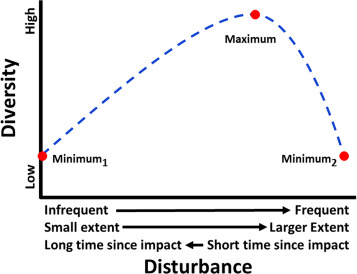
(Intermediate Disturbance Hypothesis - an overview | ScienceDirect Topics)
Why am I explaining this now and not before? Because of something here that I noticed and is critical get its own section.
there is a plan to make a change when they reach the multicellular stage regarding food perception of the first multicellular life according to the following quote:
The beginning of the late-multicellular phase of gameplay - the advent of macroscopic gameplay - will be a huge shift, as the player now inhabits a vast, 3D world. Players could very likely be overwhelmed at first, so the introduction to the late-multicellular phase will reflect the beginning of the Microbe Stage; slow-paced and manageable, with many free resources and minimal threat from other organisms.
The first available sources of food will be somewhat similar to the player’s experiences in the Microbe Stage - players will be foraging on microbe matts alongside the seafloor and filtering through plankton near the surfaces (represented as compound clouds). Players who have parts such as rusticyanin can eat rusted iron deposits, though the low-energy output and shrinking resource pool means most organisms will transition to a form of heterotrophy or photosynthetic-autotrophy to sustain themselves and further progress. Photosynthetic, sessile gameplay is another topic which should be addressed with a focused thread. Plankton and microbial matt density will decrease as more and more organisms develop, eventually introducing an incentive to specialize into more advanced heterotrophic diets.
-Deus-
( Multicellular Stage: The Beginning - #68 by Deus - Gameplay - Thrive Development Forum)
which is based on another post I wrote in it:
Early Mutilicellular nourishment - from fillter feeder to true predetor and they effects
Says that things are progressing, but we also need to prepare for the moment when we need to face the question - should changes be a quiet part or have a drastic effect on how we present them to the player?
What I have proposed here can contribute in a certain direction to how to try to make this process accessible - the subtle transition between a simple multicellular creature that is based on nutritional silence, to a creature whose active and dangerous search for food is its way of life, like most living creatures today. The reason for this lies in the pressure from environmental changes that forces them to try to adapt quickly or become extinct along the way. It is a concept that goes one by one - “the creature walks on its stomach” and develops accordingly.
This is a change that has shown to be small and gradual over time, but for our player, it can be critical if he doesn’t pay attention to the signs.
Explaining it in words can alienate people (I’m in the same category, I’m not an effective reader), so it’s okay to use visual aids to illustrate the deaf:
The color of the bacterial substrate (matte) changes over time or there are holes that grow larger indicating the disappearance of your food source, and you need to find an alternative way instead of forcing the player to “play it that way”. This is a game that has a linear path, but how do you get there? It’s in the player’s decision - and that’s what the game means to me at least.
Summary
- Presentation of what is extinction, mass extinction, ecological settlement and stress
- Distribution of types of extinction according to the category that represents them
- Bringing my opinion about your procedure to present them, if they are added
- How to give more meaning to the migration and extinction of species
- To connect the player’s action to the environment and vice versa
Conclusion
Extinction is part of evolution and I feel that this part is not reflected enough. I think it has a particularly great potential and if you can use them correctly, it would not only be interesting, they would also be challenging, could help the repetition of the game and give the game the special uniqueness that almost no other game on the market has.
But I’m just bragging here. It can fail hugely or not enter, but the fact that I write them, I see that there is something that can further advance the game, if they change the necessary power.
Some of what I have written is part of the material I am studying for a bachelor’s degree in life sciences, and if I contribute in any way to the development or direction of the eraser, I am more than happy to do so.
